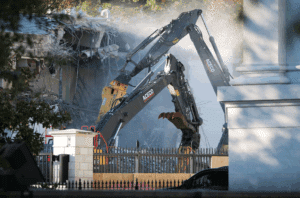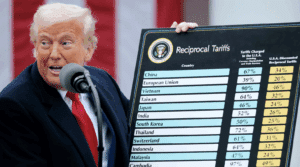
“My time as a Fellow allowed me to realize that everyone has a passion of their own, and there is space for everyone to make a positive change in their community.”
Every September, Close Up welcomes into its ranks a new class of Civic Fellows, a group of recent college graduates who spend the next nine months building experience in the world of civic education. Civic Fellows help lead our student programs, collaborate with Close Up leadership to improve our educational content, engage in ongoing professional development, and build valuable relationships with nonprofit leaders, policy experts, and elected officials as they set off on their careers.
It was this program that brought Charlotte Thomson (Civic Fellow, 2024) to Close Up and even inspired her to stay on as the Foundation’s partnerships coordinator. Read on to learn about Charlotte’s experience and the many lessons and skills she gained that she still carries with her.
What inspired you to apply for the Civic Fellowship?
My mom and my aunts went on Close Up in high school in 1989 and frequently mentioned it to me as a program that still impacts their lives today. I also knew that once I graduated college, I wanted to center my career around combatting increased partisan polarization and lost faith in democracy. When I saw the Civic Fellow opening at Close Up and the Foundation’s mission, I knew that Close Up was where I belonged, and I was excited to be a part of a cohort of similarly motivated individuals.
How did your background, studies, or interests connect to this opportunity?
I grew up in the D.C. area, so from a young age I was very primed to the world of politics. When I went to college in Minnesota, that passion only grew. I majored in biology and political science, with a focus in international relations. In my studies and experience beginning college shortly after George Floyd was killed in Minneapolis, I became hyperaware of the massive rift we have in our country between people who disagree politically and the growing apathy for our democracy. I knew that I wanted to begin my career path after college with a meaningful organization who was trying to combat this polarization, instead of feeding into it. Being a Civic Fellow at Close Up was the perfect way for me, a doer, to create positive and lasting impacts.
What did a typical day or week look like?
Once you begin as a Civic Fellow, you undergo 120 hours of in-depth training in multipartisan curriculum, conflict management, and storytelling. The training staff at Close Up met me where I was, making sure I and the other Fellows felt more than prepared and fully confident to work with students and engage them meaningfully. Training ends in late October, and my first program week instructing students was in early November. It’s very much an ease-in process once you begin instructing, which I found very beneficial. I had plenty of time to rework, reflect, and build my skills after my first 2-3 programs. Around the holidays, there is follow-up training to further hone in the skills we build as Fellows. The more regular program routine started in January, where I’d typically work three weeks “on” and one week “off” or on call.
Was there a particular program or project that stood out?
My favorite D.C. lesson of all time is the high school Mock Congress large-group activity and the Issues in Congress Workshop. Seeing students work together to make a team argument and model a civil debate, then take those skills and arguments into a Mock Congress setting, would always be the highlight of my week. They always pushed themselves out of their comfort zones to learn and grow, whether it was adopting a perspective they might have disagreed with or by stepping into a large-group speaking role.
Were there any students, teachers, or colleagues who made a particular impact on you?
I loved getting to instruct Close Up’s D.C. program supported by the Department of the Interior, where I got to teach Pacific Islanders from Guam, Palau, and the Marshall Islands. I also really loved getting to instruct two of Close Up’s Programs for New Americans in the summer. Both of these programs had such incredible students, and I was able to make really meaningful connections with these students that I still look back on today. Many came up to me at the end of the program and told me how devastated they were to leave; they just had the best time learning and making such great friends. That kind of community building is really what Close Up is about for students, and why I came in every week so motivated and encouraged to teach.
What skills or perspectives did you develop through the experience?
I developed a multitude of extremely valuable skills, but multipartisanship is the one that I think of the most. Before coming to Close Up, I had no idea what multipartisanship was, but it is something that I would say was hallmark to my Civic Fellow experience. For me, multipartisanship was not just being able to combat personal political biases and highlighting many political perspectives for students, but also a standard to which I held myself in my own personal life. As a Fellow and now, I use multipartisanship to challenge and deepen my own curiosity and understanding of the political world around me.
How did the Civic Fellowship change the way you think about leadership, community, or civic life?
Prior to beginning the Civic Fellowship, it was very easy to feel hopeless about the current state of political polarization and sympathize with other people I knew that would often say things like, “Why vote? There’s no point.” However, my time as a Fellow allowed me to realize that everyone has a passion of their own, and there is space for everyone to make a positive change in their community—whether that be through government or otherwise. This realization was fundamentally shaped by my students. Hearing them talk about the issues they cared about, experiences in their communities, and how they’re processing the politics around them gave me so much hope that young people want to make a difference. They’re just often not given the proper tools to see how they can do it, which is why Close Up is so important.
How did it influence your career path or studies?
After my time as a Civic Fellow, I knew that I wanted to remain at Close Up to continue the incredible work that we put out into the world. I also realized once I began teaching that I wanted to go back to school to pursue a master’s degree. At the end of the Fellowship, I began a full-time position as a partnerships coordinator in Close Up’s Development Department, where I am now. I am also in my first year of my Master of Public Policy at George Washington University.
What lessons or habits from your time as a Civic Fellow do you still carry with you?
The biggest lesson I learned from my time as a Civic Fellow is not to make assumptions about others. “Assuming positive intent” is one of the community guidelines we go over with our students every week, and I’ve adopted it as a big guiding principle in my life since then. It’s such an essential habit to hold for public servants and people who want to make meaningful change, because you have to put in the effort to get to know people as they are, not who you might assume them to be.
Fill out an interest form if you’re interested in joining the 2026-27 class of Close Up Civic Fellows! Or, if you’re looking to begin your career with Close Up sooner, check out our civic program instructor position—applications are now open for a February 2026 start!


 Last month, President Donald Trump had the entire East Wing of the White House demolished to prepare for construction of a 90,000-square-foot ballroom.1 The White House made the announcement and released renderings of the ballroom three months prior, noting that the current building lacked space large enough “to host major functions honoring world leaders and other countries without having to install a large and unsightly tent approximately 100 yards away from the main building entrance.”2 The president later spoke to reporters from the roof of the White House while surveying the grounds.3
Last month, President Donald Trump had the entire East Wing of the White House demolished to prepare for construction of a 90,000-square-foot ballroom.1 The White House made the announcement and released renderings of the ballroom three months prior, noting that the current building lacked space large enough “to host major functions honoring world leaders and other countries without having to install a large and unsightly tent approximately 100 yards away from the main building entrance.”2 The president later spoke to reporters from the roof of the White House while surveying the grounds.3 This morning, the Supreme Court heard oral argument in Learning Resources, Inc. v. Trump, a case which was consolidated with Trump v. V.O.S. Selections, Inc. The cases challenge whether a president can use the International Emergency Economic Powers Act (IEEPA)—a Cold War-era statute—to impose sweeping tariffs on imports by declaring an economic “emergency.”1
This morning, the Supreme Court heard oral argument in Learning Resources, Inc. v. Trump, a case which was consolidated with Trump v. V.O.S. Selections, Inc. The cases challenge whether a president can use the International Emergency Economic Powers Act (IEEPA)—a Cold War-era statute—to impose sweeping tariffs on imports by declaring an economic “emergency.”1 The 12th Annual Close Up Summit opened with a blend of tradition, inspiration, and civic pride as Governor Pulaali”i Nikolao Pula joined a panel of guests and student delegates from high schools across the territory. Held at the Governor H. Rex Lee Auditorium, the summit was hosted in partnership with the American Samoa Department of Education, bringing together students, educators and leaders to explore foundations of leadership, public service, and hold discussions on government issues and collaborate on solutions.
The 12th Annual Close Up Summit opened with a blend of tradition, inspiration, and civic pride as Governor Pulaali”i Nikolao Pula joined a panel of guests and student delegates from high schools across the territory. Held at the Governor H. Rex Lee Auditorium, the summit was hosted in partnership with the American Samoa Department of Education, bringing together students, educators and leaders to explore foundations of leadership, public service, and hold discussions on government issues and collaborate on solutions.






